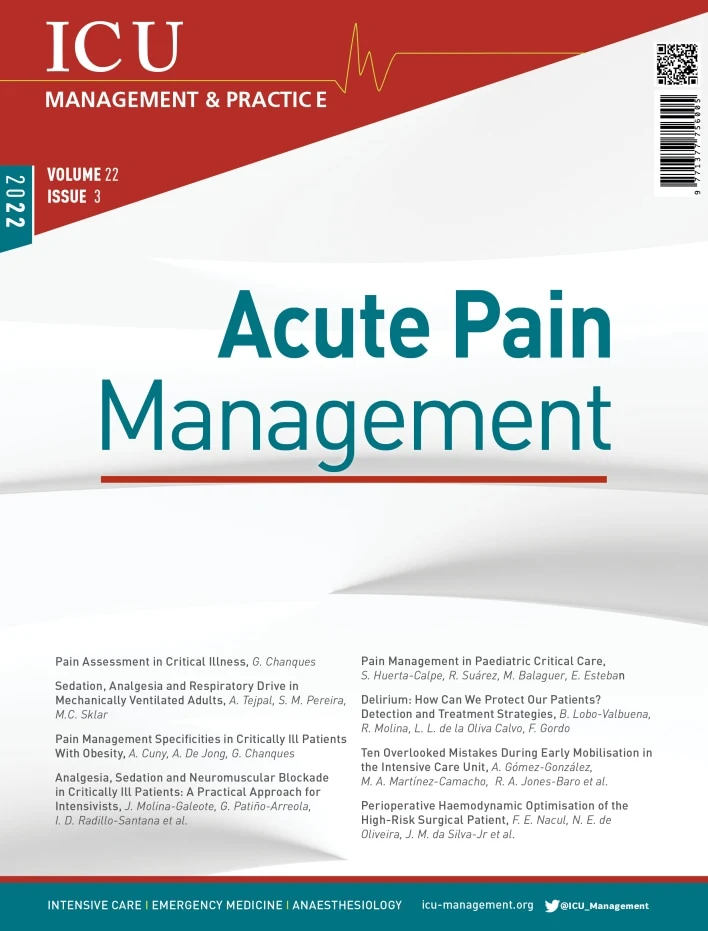
ICU Management & Practice, Volume 22 - Issue 3, 2022
Download PDF |
 |
| PRINT OPTIMISED |
Download PDF |
 |
| SCREEN OPTIMISED |
Editorial
Acute Pain Management
Pain is frequently encountered in intensive care unit (ICU) patients. Several studies have shown that improved pain management is associated with improved patient outcomes. However, pain management continues to be a significant challenge in the ICU setting. Effective pain relief is one of the most important priorities in the ICU. The goal is to ensure optimised clinical outcomes and patient comfort. Howe...
Point-of-View
Practical Implementation of the Pancreatic Stone Protein Sepsis Test
An overview of a discussion on sepsis and the Pancreatic Stone Protein (PSP) biomarker by Dr João Pereira, Hospital De Vila Franca De Xira, Portugal and how it can be used for early diagnosis of sepsis and facilitate decision-making regarding the administration of antibiotics. The discussion was chaired by Prof Pedro Póvoa, coordinator of the Intensive Care Unit (ICU) at Hospital de Sao Francisco Xavier,...
Acute Pain Management
Pain Assessment in Critical Illness
This narrative paper reports the practical assessment of pain in critically ill (ICU) patients, based on current evidence and guidelines. Pain is one of the top stressful symptoms experienced by critically ill patients hospitalised in intensive care units (ICU) (Chanques et al. 2015). This is because critical pathologies are often severely painful (i.e. trauma, surgery, acute pancreatitis…), and becaus...
Sedation, Analgesia and Respiratory Drive in Mechanically Ventilated Adults
An overview of the cardiovascular and respiratory effects of sedative agents commonly used in the ICU, emerging concepts of mechanical ventilation induced injury to the respiratory muscles and evolving concepts for sedation monitoring and sedation minimisation to achieve the goal of expeditious liberation from mechanical ventilation. Mechanical ventilation is the most widely used form of life support empl...
Pain Management Specificities in Critically Ill Patients With Obesity
In patients with obesity, standard, non-weight-based dosing, or weight-based dosing using either ideal body weight or adjusted body weight, is appropriate to limit the risk of overdosing. The prevalence of obesity is increasing worldwide (Schetz et al. 2019). This trend is confirmed in the Intensive Care Unit (ICU) where patients with obesity represent 15% to 40% of the population (Schetz et al. 2019; De...
Analgesia, Sedation and Neuromuscular Blockade in Critically Ill Patients
A Practical Approach for IntensivistsA practical approach to analgesia, sedation and neuromuscular blockade of critically ill patients and a discussion on potential benefits, adverse effects and current professional international recommendations. Patients hospitalised in the Intensive Care Unit (ICU) are naturally prone to experience pain. They may require administration of sedatives and even neuromuscula...
Pain Management in Paediatric Critical Care
An overview of the main treatment options currently available in paediatric critical care setting. Critically ill paediatric patients often suffer from pain secondary to trauma, complex medical procedures, invasive testing monitoring devices and illness-induced discomfort. Although the gold standard for assessing patient comfort is self-report, in paediatrics it may be quite difficult due to the wide spec...
Point-of-View
Nutrition Monitoring and Patient Data Management Systems
An overview of nutritional targets and their impact on critically ill patients and the need to use a systematic approach to nutritional support for optimal patient outcomes. Critically ill patients are often hypermetabolic and catabolic and are at a higher risk of underfeeding. Nutritional support for these patients can prevent energy deficits and improve outcomes (Villet et al. 2005). Underfeeding criti...
Other Feature Articles
Delirium: How Can We Protect Our Patients? Detection and Treatment Strategies
In this article, the authors aim to summarise the current management of delirium, emphasising new publications and possible new studies that will shed light on delirium management strategy. According to an updated nomenclature of delirium after an interdisciplinary panel of experts from ten medical societies (Slooter et al. 2020), delirium refers to a clinical state characterised by a combination of featu...
Ten Overlooked Mistakes During Early Mobilisation in the Intensive Care Unit
An overview of the most common mistakes in decision making and the practice of early mobilisation in the intensive care unit. Early mobilisation (EM) is a therapeutic strategy implemented to avoid and overcome impairments developed due to critical illness and ICU stay. Several benefits have been described throughout the literature such as overcoming ICU acquired weakness, reduction in days of mechanical v...
Perioperative Haemodynamic Optimisation of the High-Risk Surgical Patient
An overview of evidence supporting perioperative haemodynamic optimisation in high-risk surgery patients and strategies to facilitate its implementation and adoption to improve patient outcomes. A million surgical procedures performed every year worldwide are at risk of complications that can be attributed to the nature of the surgery and/or the physiological status of the patient. Although high-risk surg...
DigiConf
Pain Management in the ICU
Effective pain relief is one of the most important priorities in the ICU. Join our panellists as they discuss different aspects of pain management in critically ill patients and the use and effects of analgesia and sedation in the ICU. Moderator Jean-Louis Vincent (MODERATOR) Editor-in-Chief ICU Management & Practice Professor Department of Intensive Care Erasme Hospital Université libre de Bruxell...
Agenda
Upcoming events/courses/congresses
JUNE 1-3 ERAS 2022 – World Congress Madrid, Spain https://iii.hm/1eh0 4-6 Euroanaesthesia 2022 Milan, Italy https://iii.hm/1eh5 4-7 45th Annual Conference on Shock Toronto, Canada https://iii.hm/1exk 14-16 40th Vicenza Course on AKI&CRRT Vicenza, Italy / Hybrid https://iii.hm/1exl 15 ICU Management & Practice DigiConf Pain Management in the ICU Virtual Event https://iii.hm/1g27 23-25 ESI...
















